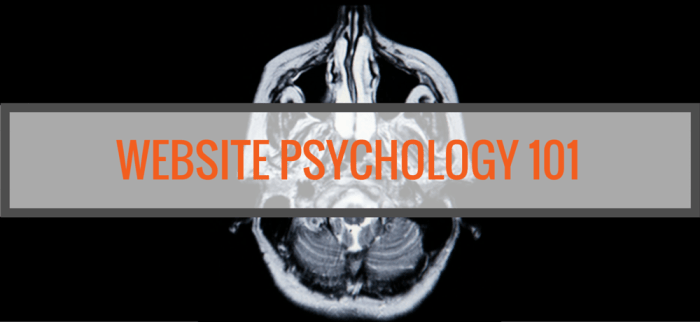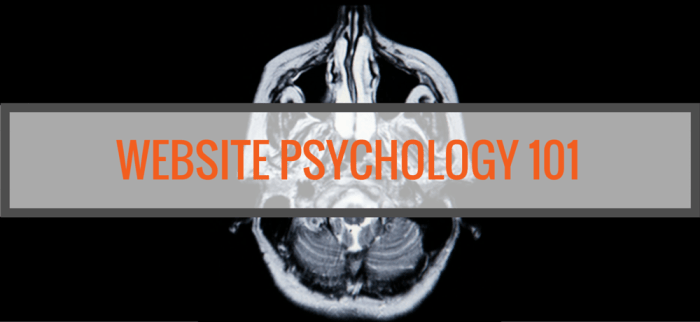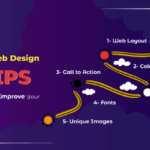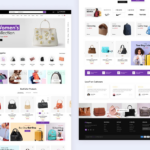Psychological principles converting websites are the key to unlocking higher conversion rates. Understanding user psychology, website design principles, content strategy, and conversion optimization strategies are crucial to creating a website that not only looks good but also encourages users to take desired actions. This comprehensive guide delves into the nuances of human behavior to provide actionable insights for building a user-centered and highly effective website.
This exploration will analyze how to craft websites that resonate with users on a deeper level, influencing their choices and ultimately driving conversions. We’ll examine various psychological factors, design principles, and content strategies, offering practical applications and illustrative examples to demonstrate their impact.
Understanding User Psychology: Psychological Principles Converting Website
Understanding the psychology behind user behavior is crucial for creating effective websites. It’s not just about aesthetics; it’s about tapping into the mental processes that drive users to interact with your site and ultimately convert. By recognizing common psychological biases and motivations, you can craft a user experience that resonates deeply and leads to higher conversion rates. This understanding goes beyond simply knowing what users
say* they want; it delves into the often-unconscious factors that shape their choices.
Knowing what motivates users to engage and convert is paramount. This understanding can be applied to design elements, copy, and overall website structure, leading to significant improvements in performance. By acknowledging the subtle influences that drive decision-making, website owners can create experiences that resonate with users on a deeper level, encouraging desired actions.
Common Psychological Biases Affecting Conversions
Many psychological biases influence user decisions on websites. These cognitive shortcuts can significantly impact conversion rates, whether it’s the desire for social proof or the fear of missing out. Understanding these biases allows you to design experiences that mitigate negative impacts and capitalize on positive ones.
- Anchoring Bias: Users often rely on the first piece of information they encounter (the “anchor”) when making decisions. For example, presenting a high-priced product first, followed by a more affordable option, can make the latter seem like a better value, even if it’s not objectively the best. To counteract this, present various options simultaneously and avoid a clear hierarchy of “better” or “worse” choices.
Understanding psychological principles is key to crafting a website that converts. It’s not just about aesthetics; it’s about tapping into user needs and desires. For example, businesses looking to create value in B2B markets create value in b2b markets often need to showcase expertise and build trust. Ultimately, these psychological levers are what drive successful conversions, whether it’s a B2B lead generation or a consumer purchase.
- Confirmation Bias: Users tend to favor information that confirms their existing beliefs. If a website’s messaging aligns with a user’s preconceived notions, they’re more likely to trust and engage with it. Consider creating content that caters to various perspectives and acknowledges potential counterarguments.
- Loss Aversion: People tend to feel the pain of a loss more strongly than the pleasure of an equivalent gain. Highlighting potential losses if a user doesn’t act (e.g., “Limited-time offer,” “Last chance”) can be effective, but use it cautiously, as excessive use can appear manipulative.
Leveraging Biases for Improved Design and Copy
Once you understand these biases, you can adapt your website design and copy to maximize conversion rates. Tailoring messaging to specific biases can significantly impact user engagement.
- Social Proof: Testimonials, reviews, and social media shares demonstrate that others find value in your product or service. Displaying these prominently can build trust and encourage conversions. This method relies on the tendency for people to follow the actions of others.
- Scarcity: Creating a sense of urgency, such as highlighting limited-time offers or low inventory, can motivate users to act quickly. The fear of missing out (FOMO) is a powerful driver. This is effectively applied to time-sensitive promotions or exclusive products.
Techniques for Identifying User Needs and Motivations
Understanding user needs and motivations is key to creating a website that resonates. Employing various research methods helps uncover user needs.
- User Interviews: Directly asking users about their needs, motivations, and pain points through one-on-one conversations provides valuable insights. This approach is particularly effective in uncovering nuanced user experiences and uncovering hidden needs.
- Surveys: Surveys allow gathering large amounts of data quickly, capturing user opinions and preferences on various aspects of the website. Using a combination of open-ended and multiple-choice questions is ideal to obtain both general feedback and specific details.
- A/B Testing: Comparing different versions of website elements (e.g., headlines, calls to action) to see which performs better helps identify what resonates with users. This provides concrete data on the effectiveness of different approaches.
Methods for Understanding User Behavior on Websites
Observing how users interact with your website provides invaluable insights. Analyzing this behavior is crucial to improve the user experience.
- Heatmaps: Visual representations of where users click and scroll on a webpage. Understanding areas of high interaction helps identify elements that need attention.
- Clickstream Data: Tracking user interactions on a website, including pages visited, time spent, and actions taken, gives a comprehensive view of user journeys. This data provides a deep dive into user behavior patterns.
- Session Recordings: Recording user sessions allows observing user behavior in real-time, providing a comprehensive view of user interaction with the website. This provides the richest data on how users navigate and respond to various design elements.
Factors Influencing User Trust and Perception
Building trust is crucial for conversion. Understanding the factors that influence user trust is essential for designing a positive user experience.
- Website Security: Displaying security certifications (e.g., SSL certificates) and clear privacy policies fosters trust. A user’s perception of safety directly correlates with the trustworthiness of a website.
- Credibility: Using reputable sources, testimonials, and displaying certifications builds credibility. This ensures that the website is perceived as trustworthy and reliable.
- Design Consistency: Maintaining a consistent design across the website builds a sense of professionalism and reliability. A unified look and feel enhances the user experience and encourages trust.
Analyzing User Journeys to Identify Pain Points
Identifying pain points within the user journey is essential for improving the user experience and conversion rates.
- Mapping User Flows: Visualizing how users navigate through the website, from initial landing page to conversion, helps identify steps where users drop off. This process involves visualizing the user path and identifying areas where the user experience is problematic.
- Identifying Friction Points: Identifying obstacles or steps that impede user progress in the user journey. This helps understand where users are struggling to convert and how to optimize the process.
Website Design Principles
The visual aspects of a website are more than just aesthetics; they significantly impact user experience and ultimately, conversion rates. Understanding how color, typography, layout, and visual hierarchy work together is crucial for creating a website that not only looks good but also effectively guides users towards desired actions. Effective website design leverages these principles to enhance user engagement and drive conversions.Color psychology plays a pivotal role in shaping user perception and influencing choices.
Different colors evoke different emotional responses and can subtly nudge users towards certain actions. For instance, blue often instills trust and reliability, making it a popular choice for financial institutions. Conversely, red can stimulate urgency and is commonly used for call-to-action buttons. Careful consideration of color palettes is essential to align the website’s visual language with the brand’s identity and desired user response.
Understanding the psychological principles behind converting websites is key, but crafting compelling headlines is a crucial element in that process. A strong headline can significantly influence whether a visitor engages further with your site. Learning how to write effective headlines, which directly impact click-through rates, is a powerful tool to master. Check out this helpful guide on creating headlines for clicks to boost your website’s conversion rates, ultimately harnessing those same psychological principles to your advantage.
Color Psychology and User Choices
Color choices significantly impact user perception. Warm colors like red and orange evoke feelings of excitement and urgency, often used for call-to-action buttons or limited-time offers. Cool colors like blue and green, on the other hand, inspire feelings of trust and calmness, often employed for financial institutions or websites selling environmentally friendly products. A well-chosen color palette can influence user mood and behavior, leading to more positive interactions with the website.
Understanding psychological principles is key to crafting a converting website. It’s about more than just aesthetics; it’s about influencing user behavior. For example, using these principles in Facebook ads can significantly boost your results. Check out this great resource on better results facebook ads to see how you can improve your campaigns. Ultimately, applying these psychological principles across your entire digital strategy, from website design to social media ads, is crucial for success.
Visual Hierarchy and User Engagement
Visual hierarchy guides the user’s eye across the page, highlighting important elements and directing attention to crucial information. This is achieved through techniques like varying font sizes, using different colors, and strategically placing elements. For instance, a larger, bolder headline immediately draws attention, while smaller text provides supporting details. Properly implemented visual hierarchy ensures that users naturally focus on the most important content, leading to increased engagement and improved comprehension.
Typography and Readability
Typography significantly influences readability and user engagement. Font choices, sizes, and styles all contribute to the overall user experience. Using a clear, readable font, like Arial or Times New Roman, is vital for ensuring that users can easily digest the information presented. Font sizes should be optimized for readability on various devices and screen sizes. Pairing contrasting font styles (bold, italic, or different sizes) helps emphasize critical elements, like headings or important calls to action.
A well-chosen typography scheme enhances readability, improving the user experience.
User-Centered Design for Conversion
User-centered design focuses on understanding user needs and behaviors to create a website that effectively meets those needs. This includes considering factors like user navigation patterns, common pain points, and desired outcomes. For instance, a clear and intuitive navigation structure helps users quickly find the information they need, while strategically placed calls to action encourage desired behaviors. Thorough user research and testing are vital for ensuring that the website aligns with user expectations.
Design Elements Fostering Trust and Credibility
Several design elements contribute to building trust and credibility on a website. These include clear and concise website copy, verifiable contact information, secure payment gateways, testimonials, and clear return policies. Incorporating trust badges, such as security seals or customer reviews, further reinforces the website’s credibility. These elements instill confidence in users, encouraging them to interact with the site and make purchases.
Website Layout Approaches for Optimization
Different website layouts can significantly impact conversion rates. A clean and uncluttered layout, focusing on essential information, can improve user experience. A layout that prioritizes a clear call to action and provides a seamless user journey, leading users from one stage to the next, often achieves higher conversion rates. A well-organized layout ensures that users easily find the information they need and are guided toward the desired actions.
For example, a simple, single-column layout can be effective for e-commerce sites where product showcases are paramount. Conversely, a multi-column layout might be beneficial for complex websites requiring the presentation of varied content types. Careful consideration of the site’s purpose and target audience is crucial in choosing the most suitable layout.
Content Strategy and Persuasion
Crafting compelling content is crucial for any website aiming to convert visitors into customers. This involves more than just attractive design; it demands a strategic approach to language, storytelling, and persuasive techniques. Understanding the psychology behind user behavior is key to creating a content strategy that resonates with your target audience and encourages them to take desired actions.A successful content strategy isn’t about manipulating users; it’s about understanding their needs and motivations, and presenting your offerings in a way that aligns with those needs.
This approach builds trust and encourages engagement, ultimately driving conversions.
Writing Styles for Rapport
Establishing rapport with website visitors is fundamental to successful persuasion. Different writing styles can effectively connect with different audiences. A conversational tone, for example, can foster a sense of community and familiarity. Employing a professional, authoritative tone is suitable for showcasing expertise and reliability, particularly in industries like finance or legal services. Finding the appropriate tone for your brand and audience is essential for building a strong connection.
Compelling Copy for Action
Creating copy that motivates action involves more than just listing features. Highlighting the benefits and positive outcomes associated with using your product or service is crucial. Focus on addressing the pain points and desires of your target audience. For instance, instead of simply stating a product feature, emphasize how it solves a problem or enhances a user’s life.
Weaving compelling narratives and focusing on the emotional impact of the product or service will resonate with your audience more deeply.
Storytelling for Engagement
Storytelling is a powerful tool for boosting user engagement and driving conversions. Stories create emotional connections, making your brand more relatable and memorable. By incorporating real-life examples or scenarios, you can illustrate the value proposition of your product or service in a way that resonates with your audience. Imagine a software company that shares a story about how their product helped a small business owner overcome a significant challenge.
This approach makes the product more human and impactful.
Persuasive Language Techniques
Utilizing persuasive language techniques can subtly influence user choices. Techniques such as social proof, scarcity, and authority can effectively persuade users. Social proof, for example, can be implemented by displaying testimonials or customer reviews. Scarcity can be effectively utilized by highlighting limited-time offers or exclusive discounts. Authority can be built by featuring endorsements from industry experts or credible organizations.
These techniques can be integrated into website copy to nudge users towards the desired actions.
Clear Calls to Action (CTAs)
Clear calls to action are essential for guiding users toward the desired next step. These calls to action should be concise, prominent, and easy to understand. Using strong action verbs, such as “Buy Now,” “Sign Up,” or “Learn More,” is crucial. The color and font used for CTAs should stand out from the surrounding content, making them easily identifiable.
A well-designed CTA can significantly improve conversion rates.
Personalizing Content for Enhanced Experience
Personalization is a key element for enhancing user experience. Tailoring content to individual user preferences, behaviors, and needs fosters a sense of connection. For instance, offering personalized recommendations based on previous browsing history or purchase patterns can increase engagement. Providing customized content based on user demographics, interests, or location can further enhance the experience and encourage conversions.
Conversion Optimization Strategies
Turning website visitors into paying customers requires a deep understanding of user behavior and psychology. Conversion optimization strategies are not just about aesthetics; they’re about crafting a seamless experience that encourages desired actions. This involves understanding the psychological triggers that prompt immediate action, optimizing navigation, utilizing social proof effectively, minimizing friction points, and identifying the reasons behind abandonment.Successful conversion optimization blends user-centered design with data-driven analysis.
By understanding what drives users to take the next step, businesses can improve their conversion rates significantly. This includes recognizing patterns in user behavior and utilizing proven techniques to increase engagement and drive conversions.
Psychological Triggers for Immediate Action
Understanding the psychological triggers that encourage immediate action is key to conversion optimization. These triggers often tap into fundamental human needs and desires. Fear of missing out (FOMO), urgency, and scarcity are powerful motivators. For instance, displaying limited-time offers or highlighting the popularity of a product can create a sense of urgency and drive immediate purchases. Highlighting limited quantities of a product or service can also trigger a desire to act quickly to avoid missing out.
Optimizing Website Navigation for Conversions
Intuitive and user-friendly navigation is crucial for a positive user experience. A well-structured website allows visitors to easily find the information they need, leading to higher engagement and conversion rates. Clear calls-to-action (CTAs) should be strategically placed throughout the website. Consider using a consistent layout and visual hierarchy to guide users through the site. Easy access to product information, contact details, and return/refund policies are critical for minimizing friction and improving conversion rates.
Different Approaches to Implementing Social Proof
Social proof plays a significant role in influencing user behavior. It builds trust and credibility by demonstrating that others have already chosen or benefited from a particular product or service. Several methods exist, including testimonials, reviews, ratings, and social sharing buttons. Using multiple forms of social proof can increase the perceived credibility of the product or service.
For example, a product page featuring positive customer reviews and a prominent display of the number of social shares enhances the likelihood of conversion.
Techniques for Reducing Website Friction
Friction on a website can stem from various sources, including unclear instructions, complicated processes, or excessive form fields. Streamlining the checkout process, providing clear and concise instructions, and simplifying form fields can significantly reduce friction. Ensuring fast loading speeds and mobile responsiveness also contribute to a positive user experience, reducing friction and improving conversions. Easy-to-understand FAQs, helpful product descriptions, and detailed return policies are critical to addressing potential concerns and reducing friction.
Factors Contributing to Website Abandonment
Website abandonment is a significant concern for businesses. Understanding the reasons behind this behavior is essential for developing targeted strategies to improve conversion rates. Factors that contribute to abandonment include complicated checkout processes, unexpected costs (e.g., shipping), and concerns about security. Difficulties with completing forms, hidden fees, and a lack of trust can all contribute to website abandonment.
Increasing User Engagement through Interactive Elements
Interactive elements can significantly increase user engagement and drive conversions. Interactive elements include quizzes, polls, games, and calculators. These elements can make the user experience more engaging, create opportunities for interaction, and ultimately drive conversions. For instance, a quiz that helps users identify the perfect product can lead to increased engagement and conversion rates. Interactive elements help retain attention, and make the website more enjoyable.
Using these interactive elements provides value to the user, leading to increased engagement and conversion rates.
Illustrative Examples

Understanding user psychology is crucial for creating effective websites. Illustrative examples, from color psychology to user journey maps, can help us understand how to design for maximum impact. By examining these examples, we can gain practical insights into applying psychological principles to improve user experience and conversion rates.
Color Psychology and Website Design
Color plays a significant role in evoking emotions and influencing user behavior. Different colors can create different moods and associations, affecting how users perceive a website and ultimately, their likelihood of converting.
| Color | Emotion Evoked | Example Usage on a Website | Impact on Conversion |
|---|---|---|---|
| Red | Energy, excitement, urgency | Using red buttons for “Add to Cart” or “Buy Now” | Can increase urgency and drive immediate action, potentially boosting conversion rates. However, overuse can be overwhelming. |
| Blue | Trust, reliability, calmness | Using blue as the primary color for a financial website or a website selling products requiring high levels of trust. | Inspires confidence and promotes a sense of security, which can lead to higher conversion rates. |
| Green | Growth, nature, harmony | Using green as a color for a website focused on eco-friendly products or health | Conveys a sense of health and well-being, potentially influencing user perception positively and impacting conversions. |
| Yellow | Happiness, optimism, attention | Using yellow as a highlight color on a website to draw attention to important information or calls to action. | Can grab attention and create a sense of optimism, potentially leading to increased conversions. Overuse can be distracting. |
| Purple | Luxury, creativity, sophistication | Using purple for a website selling high-end products or services. | Can convey a sense of luxury and exclusivity, potentially increasing conversion rates for premium products. |
User Journey Map Example
A user journey map visually represents a user’s experience with a website or product. It helps identify pain points and opportunities for improvement.
A user, researching a new laptop, visits a website. They start by browsing different models, but struggle to filter by price range. They find the specifications unclear, and encounter a confusing checkout process with multiple steps. Finally, they abandon the purchase. A journey map highlights this frustration.
Opportunities for improvement include clearer filtering options, more detailed product descriptions, and a streamlined checkout process.
Persuasive Techniques in Website Copy
Persuasive techniques in website copy can significantly influence user behavior. These techniques can increase the likelihood of users taking the desired action, like making a purchase or signing up for a newsletter.
| Technique | Example | Explanation | Impact on Conversion |
|---|---|---|---|
| Scarcity | “Only 5 left in stock!” | Creates a sense of urgency and limited availability. | Increases the sense of urgency and encourages immediate action. |
| Social Proof | “90% of users recommend this product.” | Leverages the opinions of others to build trust and credibility. | Increases trust and encourages conversions based on perceived value from other users. |
| Authority | “Endorsed by industry experts.” | Emphasizes expertise and credibility. | Inspires confidence and encourages trust in the product or service. |
| Reciprocity | Offering a free trial or sample | Creates a sense of obligation to return the favor. | Encourages users to explore and try the product. |
Optimized Website Layout
A well-designed website layout is crucial for user experience and conversion. The layout should be visually appealing and easy to navigate, guiding users seamlessly through the website. This optimized layout should be user-centered and intuitive.
A well-optimized layout prioritizes clear calls to action, prominent placement of essential information, and intuitive navigation. A visually appealing website design can significantly impact the user experience and conversion rates. Using a grid system, strategically placing high-value content, and incorporating white space can create a visually appealing and user-friendly layout. This approach can improve readability, navigation, and visual appeal.
Trust Signals and Implementation
Trust signals are crucial for building confidence and encouraging conversions. They assure users that the website is legitimate and trustworthy.
Implementing trust signals can significantly improve user trust. Examples include security badges (HTTPS), customer testimonials, money-back guarantees, and clear return policies. Displaying these trust signals creates confidence and reinforces the legitimacy of the website, ultimately leading to higher conversion rates.
Interactive Elements for Engagement
Interactive elements can significantly enhance user engagement and improve conversion rates. These elements should be intuitive and contribute to the overall user experience.
Interactive elements, such as quizzes, polls, and interactive maps, can make a website more engaging and memorable. They draw users into the website and can increase engagement. Integrating interactive elements should be done thoughtfully and strategically, with clear purpose and design.
Specific Design Considerations

Crafting a website that converts hinges on understanding how users perceive and interact with it. Beyond the fundamental principles of design and content, specific tactics are crucial for triggering the desired psychological responses. Effective implementation of these strategies can significantly boost conversion rates.
Scarcity Tactics
Implementing scarcity effectively on a website is crucial for creating a sense of urgency and desirability. However, ethical considerations must be paramount. Avoid misleading users or creating false scarcity. Instead, focus on presenting limited-time offers or highlighting exclusive content.
- Highlight time-sensitive offers: Clearly display deadlines and timers for promotions or limited-quantity products. A countdown timer can be visually engaging and immediately communicate the sense of urgency.
- Showcase exclusive content: If a specific piece of content is limited to registered users, clearly state this. For example, “Only registered users can access this exclusive report.” This can be a powerful incentive.
- Employ limited quantities: Displaying a specific number of items left in stock effectively utilizes the scarcity principle. Visual cues, like a “low stock” notification, add a touch of immediacy.
- Avoid artificial scarcity: Do not create false scarcity or manipulate the information to mislead the customer. This can damage trust and reputation.
Urgency Design Principles
Creating a sense of urgency encourages immediate action. This is best achieved through well-designed elements that communicate time constraints or limited availability.
- Use countdown timers: Incorporate visual timers that display the remaining time for promotions, sales, or other time-limited offers. Timers should be clear and easy to understand.
- Highlight deadlines: Clearly state the end date or time for special offers or promotions. Emphasize the impending expiration date to reinforce the urgency.
- Employ limited-time offers: Frame promotions as time-bound to encourage immediate purchase decisions. For example, “Limited-time offer: 20% off for the next 48 hours.”
- Use strong calls to action: Use compelling language and phrases that emphasize the urgency of the situation. For example, “Shop now,” “Order before midnight,” or “Don’t miss out.” Ensure these are strategically placed to drive immediate action.
Reciprocity for Trust Building
Reciprocity is a powerful tool for fostering trust and encouraging user action. By offering something of value upfront, you create an obligation for the user to reciprocate.
- Offer valuable free resources: Provide free e-books, checklists, or templates that align with your target audience’s needs. This sets the stage for a mutually beneficial exchange.
- Provide exclusive content: Grant access to special content, such as webinars or early bird discounts, to users who take a specific action. This rewards engagement and incentivizes reciprocity.
- Personalize interactions: Use user data to tailor offers and interactions to specific users. This demonstrates a personalized approach, which is often reciprocated with trust and positive engagement.
Social Proof Implementation, Psychological principles converting website
Social proof leverages the tendency of people to follow the actions of others. Implementing it effectively can significantly influence purchasing decisions.
- Display customer testimonials: Showcase positive reviews and testimonials from satisfied customers. This builds credibility and reassures potential buyers.
- Highlight social media engagement: Display social media shares, likes, and comments to demonstrate the popularity and value of your product or service.
- Incorporate ratings and reviews: Clearly display ratings and reviews from previous customers. This provides social proof and enhances trust.
Clear Website Copy Structure
Clear and concise website copy is crucial for guiding users and encouraging desired actions. Ambiguity can lead to confusion and lost conversions.
- Avoid jargon and technical terms: Use language that is easily understandable by the average user. Avoid technical terms or jargon unless absolutely necessary.
- Employ concise and direct language: Cut through the noise and communicate your message in a straightforward manner. Use clear and direct language to convey your value proposition effectively.
- Structure information logically: Organize information logically and clearly to enhance readability and comprehension. This improves the user experience and fosters a positive impression.
Community and Belonging
Creating a sense of community and belonging fosters a deeper connection with users, driving loyalty and advocacy.
- Encourage user interaction: Create opportunities for users to connect with each other, such as forums, groups, or social media pages. This fosters a sense of belonging.
- Foster a sense of shared experience: Share success stories, testimonials, or other content that resonates with users and creates a sense of community.
- Run contests and challenges: Organize engaging contests or challenges to encourage user participation and foster a sense of shared experience.
Final Summary
In conclusion, crafting a successful website requires a deep understanding of human psychology. By applying the principles discussed in this guide, you can create a website that resonates with users, builds trust, and encourages conversions. Remember that a user-centered approach, incorporating insights from psychology, design, and content strategy, is paramount to maximizing your website’s potential. This detailed exploration of psychological principles offers a roadmap for creating websites that are not just aesthetically pleasing, but also highly effective in driving conversions.






